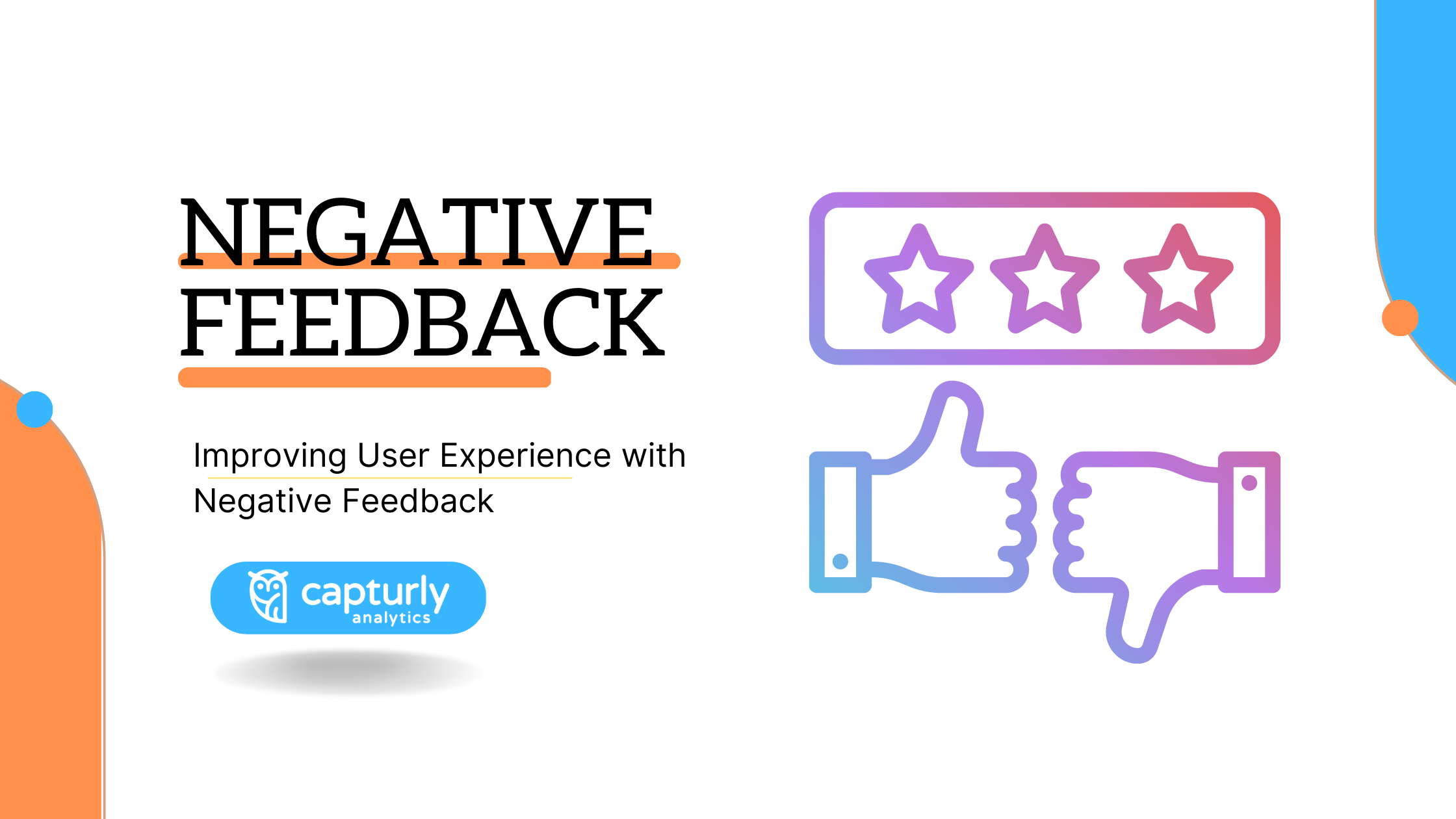Have you ever received negative reviews about something you worked on? It can be tough to hear, but when it comes to improving user experience, incorporating constructive criticism can be valuable.
Negative feedback can often provide more insight into what customers want and need. By paying attention to what they are saying you can make changes that will result in a better experience for everyone. Let’s dive in and explore how it can help improve UX.
Table of Contents
The Importance of User Feedback
First, let’s talk about the importance of customer feedback. Without it, you’re guessing about what users want and need. You may think you know, but without it, you could be making decisions that don’t align with users’ wants.
That’s why gathering it is critical for creating a positive UX. It’s how you can identify pain points, areas of confusion, and opportunities for improvement. And when you gather them, you want to hear it all.
Your users also get the satisfaction of knowing that you are giving them space to express their opinions and that you are genuinely wanting to help them. Sure, everyone only likes positive criticism, but try to think of negative criticism as free advice from your users.
What is Negative Feedback?
Negative feedback is the one that is critical of a product or service. It highlights areas of a design that are not working well, causing frustration or confusion. It can come in many forms, including direct feedback, customer reviews, and user testing results. While it can be difficult to hear, it is a need for designers to embrace it to create a successful UX.
It is also essential for creating a user-centric design. Designers can create a product that meets the needs and expectations of the customers. This is especially important in today’s market, where UX is a critical differentiator.
Why Negative Feedback Matters
So, why is negative feedback so important? Because it tells you what’s not working, and what users don’t like. While positive ones don’t always provide useful insights into how to improve. It can help you to identify specific problems and make the necessary changes to improve the UX.
Here are a few reasons why it matters:
It can uncover issues you might have missed.
Sometimes, when you’re so close to a project, it’s hard to see the forest for the trees. It can help you step back and see the big picture. You may realize there are issues you didn’t notice before.
It can lead to better solutions.
When you hear critical reviews, it’s easy to get defensive. But try to use it as an opportunity to create better solutions. By taking the time to address the issues, you can improve the experience for everyone. You might even get advice on how to improve alongside the negative criticism. Or even if you don’t get advice, don’t be afraid to ask for the opinions of those who shared their feedback with you!
It shows you care about your users.
When you seek reviews you’re demonstrating that you care about your users’ experiences. This can build trust and lead to stronger relationships with your customers.

How to Collect Negative Feedback
Now that we’ve established the importance of it, let’s talk about how to collect it. There are a few methods you can use to encourage users to share their experiences:
Surveys
One of the most common ways is through surveys. You can use email survey tools to create a survey that asks them about their experiences. Make sure you ask open-ended questions that encourage users to provide detailed ones.
User Testing
Another way is through user testing. This involves having users complete a set of tasks on your website or app, while you observe their behavior and listen to their opinion. It can provide valuable insights into what they are experiencing.
Social Media
Social media is another tool you can use to collect reviews. You can create posts asking for opinions or encourage them to reach out privately. Make sure to respond to all of them, both positive and negative.

Analyzing Negative Feedback
Once you’ve gathered them, it’s time to analyze it. This involves looking for patterns and identifying the root causes of the negative reviews.
Here are a few steps you can take to analyze it:
Identify common themes
Look for common themes or patterns. For example, do users all the time mention a certain feature that’s difficult to use or confusing? Are there specific pages or sections of your website or app that users struggle with? Identifying these patterns can help you focus on which issues to address first.
Use behavioral analytics tools
If you have received negative feedback from your audience, you can run additional analysis to find out more. Use behavioral analytics tools to get an even more accurate picture of what is causing frustration in your users. You can use session recordings which mainly concentrate on individual users or you can use heatmaps which will give you an at-a-glance overview of your audience.
Determine the root cause
Once you’ve identified the problems and patterns, try to determine the root cause of the issues. By determining the root cause, you can address the issue more effectively.
Create a plan to address the issues
Once you’ve identified the patterns and root causes, it’s time to create a plan to address the issues. This might involve redesigning a feature, adding more explanation or documentation, or fixing a technical problem. The goal is always to create a better UX.
The Role of Analytics
Analytics can play an important role in collecting and analyzing feedback. By tracking user behavior and interactions with your website or app, you can identify confusing areas. Here are a few ways analytics can help you improve UX:
Identify where users are dropping off
Analytics can also help you identify where users are dropping off or abandoning your website or app. For example, if users are leaving your website after visiting a certain page, that might show a problem with that page. You can explore these issues with session replay, where you can see the whole session that a customer spent on your website. Also, heatmaps can help too because they show if some CTA-s aren’t working.
Track user behavior
Traditional analytics can help you track customers’ behavior. Such as how long users spend on a certain page, and which features they use most. By understanding how users are interacting with your website or app, you can identify areas for improvement.
Use A/B testing
A/B testing is a method of comparing two different versions of a website or app to see which performs better. By using analytics to track user behavior and engagement, you can determine which version is more effective.

Incorporating Negative Feedback into Your UX Design Process
Now we’ve discussed the importance of incorporating negative feedback into your UX design process. Let’s take a closer look at how you can make this a regular part of your workflow.
Set up a feedback collection system
The first step to incorporating it into your UX design process is to set up a system for collecting feedback. This might involve adding a form to your website or app or sending out surveys to users.
Encourage honest feedback
It’s important to create an environment where users feel comfortable giving honest opinions. Make it clear that you welcome all feedback. Also mention that you’re committed to using these to improve the user experience.
Actively seek out feedback
Collecting them through a formal system, it’s important to actively seek out feedback from users. This might involve reaching out to users to ask for their thoughts or observations.
Analyze feedback and identify patterns
As we discussed earlier, it’s important to analyze them and identify patterns or common themes. By doing this, you can rank which issues to address first and determine the root causes of these issues.
Create a plan to address issues
Once you’ve identified the patterns and root causes of the issues, it’s time to create a plan to address these issues. This might involve making changes to your website or app design.
Test and iterate
Finally, it’s important to test and iterate on your changes to see how they impact the user experience. Use analytics to track user behavior and engagement, and make adjustments as needed.
By following these steps, you can create a continuous feedback loop that helps you improve the user experience over time.
Benefits of Incorporating Negative Feedback
Incorporating them into your UX design process can bring many benefits to your website or app, including:
Improved user experience
By addressing it, you can create a better UX. With a better user experience, you can increase engagement on your site, reach a higher rank in search engines, reduce bounce rates and enhance your brand reputation.
Increased customer loyalty
When users feel like their feedback is important and their concerns are being addressed, they’re more likely to remain loyal to your brand. They will know that they can trust you and that you care about what matters to them.
Better business outcomes
A better UX can lead to increased higher conversion rates and better business outcomes. By listening to visitors’ opinions, users run into fewer problems and they will more likely to convert.
Competitive advantage
Finally, by improving the user experience, you can create a competitive advantage over other websites or apps in your industry.

Handling Negative Feedback with a Growth Mindset
Incorporating negative feedback into your UX design process can be a powerful way to improve the user experience on your website or app. By using analytics to track user behavior you can gain even deeper insights into how to improve your business.
Remember to approach feedback with an open mind, a willingness to learn, and a commitment to improving the user experience. With these approaches, you’ll be well on your way to creating a website or app that users love to use.
It’s important to approach it with the right mindset. Here are a few tips for receiving and responding to them:
Listen without getting defensive
When someone gives you negative reviews, it can be tempting to get defensive. However, it’s important to listen to what the person is saying. Try to understand their perspective and the root cause of their frustration.
Respond politely even to inappropriate criticism
Sometimes criticism may be written in the wrong tone. Do not respond to these in the same style, as this will only start an endless and perhaps infuriating debate and will not lead to any results.
Ask clarifying questions
If the feedback is unclear, don’t be afraid to ask clarifying questions. This can help you better understand the issue and determine the best course of action to address it. It also makes a good impression on you for the reviewer.
Thank the person for their feedback
It’s important to thank the person for their opinion. This shows that you value their thoughts and are committing to improving the UX.
Follow up with action
After you’ve received it, it’s important to follow up with action. Don’t just listen to criticism, do something to make your site better and more valuable also with the help of critics.
Final thoughts
Negative feedback can be a powerful tool for improving user experience. And by using analytics to track user behavior and interactions, you can gain even deeper insights into how to improve your website or app.
So, don’t be afraid of it, embrace it as a valuable tool for creating a better user experience. And remember to approach them with an open mind, a willingness to learn, and a commitment to improving the user experience. With these approaches, you’ll be well on your way to creating a website or app that users love to use.
Don't forget, sharing is caring! :)

